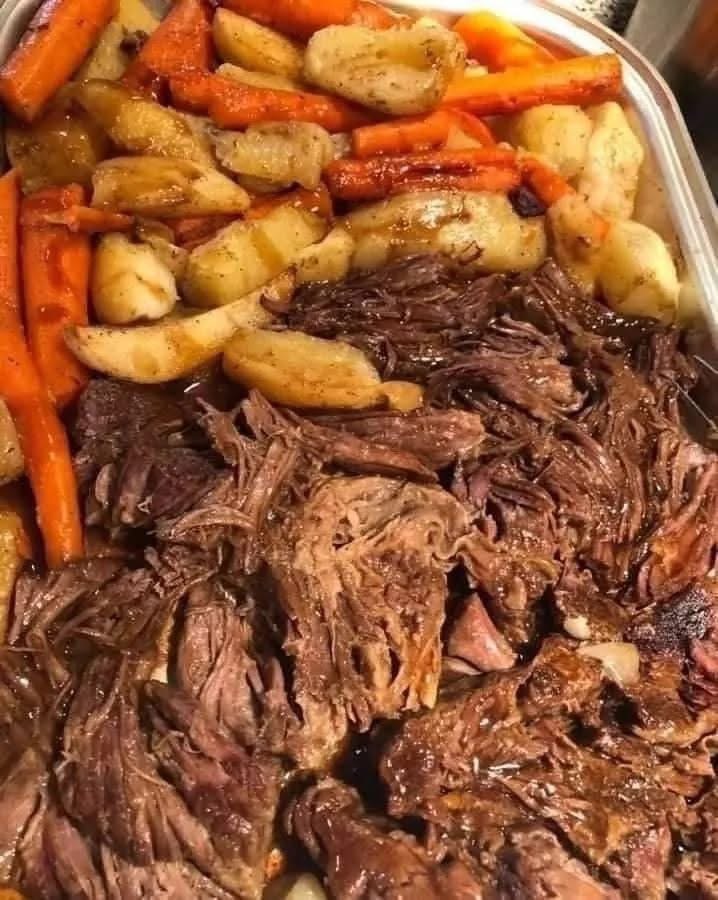Of course. A classic pot roast with potatoes is the ultimate comfort food. This method will give you a fall-apart tender roast, rich gravy, and perfectly cooked vegetables.
Classic Pot Roast with Potatoes
This recipe uses a low-and-slow braising method to transform a tough cut of meat into a succulent, flavorful masterpiece.
Prep time: 30 minutes Cook time: 3-4 hours Serves: 6-8
—
Ingredients:
· 1 (3-4 lb) chuck roast or bottom round roast (chuck has more fat and is more forgiving)
· 2 tbsp kosher salt
· 1 tbsp black pepper
· 2 tbsp all-purpose flour
· 2-3 tbsp olive oil or vegetable oil
· 1 large yellow onion, chopped
· 3-4 carrots, peeled and cut into 2-inch chunks
· 3-4 celery stalks, cut into 2-inch chunks
· 4-6 cloves garlic, minced
· 2 tbsp tomato paste
· 1 cup dry red wine (like Cabernet Sauvignon or Merlot) or additional broth
· 2-3 cups beef broth, low sodium preferred
· 1 tbsp Worcestershire sauce
· 3-4 sprigs fresh thyme (or 1 tsp dried)
· 2-3 sprigs fresh rosemary (or ½ tsp dried)
· 2 bay leaves
· 1 ½ lbs Yukon Gold or red potatoes, halved or quartered if large
—
Instructions:
1. Prep the Roast: Pat the roast completely dry with paper towels. This is crucial for getting a good sear. Generously season all sides with salt, pepper, and the flour.
2. Sear the Meat: In a large Dutch oven or heavy-bottomed pot, heat the oil over medium-high heat. Sear the roast for 4-5 minutes per side, until a deep brown crust forms. Don’t rush this step; it builds immense flavor. Remove the roast to a plate.
3. Sauté the Aromatics: Reduce the heat to medium. Add the onion, carrots, and celery to the pot. Cook for 5-7 minutes, stirring occasionally, until the onions are softened and slightly browned. Add the garlic and tomato paste and cook for 1 more minute until fragrant.
4. Deglaze: Pour in the red wine, scraping the bottom of the pot with a wooden spoon to release all the browned bits (this is called “fond” and is packed with flavor). Let the wine simmer and reduce by half, about 2-3 minutes.
5. Braise:
· Return the seared roast to the pot, along with any accumulated juices.
· Pour in enough beef broth to come about halfway up the sides of the roast. Add the Worcestershire sauce, thyme, rosemary, and bay leaves.
· Bring the liquid to a simmer, then cover the pot with a tight-fitting lid.
6. Cook Low and Slow:
· Oven Method (Preferred): Preheat your oven to 300°F (150°C). Once the pot is simmering on the stove, cover it and transfer it to the oven. Cook for 2 hours.
· Stovetop Method: Keep the pot on the stovetop at the lowest possible simmer, covered, for 2 hours. Check occasionally to ensure it’s not boiling.
7. Add Potatoes: After 2 hours, add the potatoes to the pot, submerging them in the cooking liquid as much as possible. Cover and return to the oven or stovetop for another 1 to 1 ½ hours.
8. Check for Doneness: The roast is done when it is fork-tender and easily shreds. The total cooking time will be 3 to 3 ½ hours.
9. Rest and Thicken:
· Carefully remove the roast and vegetables to a serving platter. Tent loosely with foil to keep warm.
· For Gravy: Skim off any excess fat from the surface of the cooking liquid. If you want thicker gravy, you can make a slurry: mix 2 tablespoons of cornstarch with 2 tablespoons of cold water until smooth. Bring the cooking liquid to a simmer on the stovetop and whisk in the slurry a little at a time until the gravy reaches your desired consistency. Season with salt and pepper to taste.
10. Serve: Discard the herb stems and bay leaves. Shred the roast or slice it against the grain. Serve with the potatoes and vegetables, and plenty of gravy.
—
Pro Tips for the Perfect Pot Roast:
· The Right Cut: Chuck roast is ideal because it’s well-marbled with fat, which melts during the long cooking process, making the meat incredibly tender.
· Don’t Rush the Sear: A proper, dark brown sear equals flavor. Don’t move the roast until it releases easily from the pot.
· Low and Slow is Key: A gentle oven heat cooks the meat more evenly than the stovetop and prevents the vegetables from turning to mush.
· Add Veggies Later: Adding the potatoes halfway through prevents them from overcooking and becoming waterlogged.
· Don’t Boil: Maintain a very gentle simmer. A rolling boil will make the meat tough and dry.
· Make Ahead: Pot roast often tastes even better the next day. Let it cool completely and store it in the refrigerator. Reheat gently on the stovetop.
Enjoy your hearty, home-cooked meal
